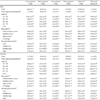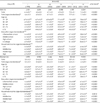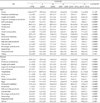1. Ministry of Health and Welfare (KR). The Korean Nutrition Society. Dietary reference intakes for Koreans 2015. Sejong: Ministry of Health and Welfare;2016.
2. Rural Development Administration (KR). Fat-soluble vitamin composition table. Suwon: Rural Development Administration;2012.
3. Sokol RJ. Vitamin E deficiency and neurologic disease. Annu Rev Nutr. 1988; 8(1):351–373.

4. Corrigan JJ Jr, Marcus FI. Coagulopathy associated with vitamin E ingestion. JAMA. 1974; 230(9):1300–1301.

5. Alpha-Tocopherol, Beta Carotene Cancer Prevention Study Group. The effect of vitamin E and beta carotene on the incidence of lung cancer and other cancers in male smokers. N Engl J Med. 1994; 330(15):1029–1035.
6. Traber MG, Atkinson J. Vitamin E, antioxidant and nothing more. Free Radic Biol Med. 2007; 43(1):4–15.

7. Bandera EV, Gifkins DM, Moore DF, McCullough ML, Kushi LH. Antioxidant vitamins and the risk of endometrial cancer: a dose-response meta-analysis. Cancer Causes Control. 2009; 20(5):699–711.

8. Ye Z, Song H. Antioxidant vitamins intake and the risk of coronary heart disease: meta-analysis of cohort studies. Eur J Cardiovasc Prev Rehabil. 2008; 15(1):26–34.

9. Li P, Zhang H, Chen J, Shi Y, Cai J, Yang J, Wu Y. Association between dietary antioxidant vitamins intake/blood level and risk of gastric cancer. Int J Cancer. 2014; 135(6):1444–1453.

10. Guo L, Zhu H, Lin C, Che J, Tian X, Han S, Zhao H, Zhu Y, Mao D. Associations between antioxidant vitamins and the risk of invasive cervical cancer in Chinese women: a case-control study. Sci Rep. 2015; 5:13607.

11. Li FJ, Shen L, Ji HF. Dietary intakes of vitamin E, vitamin C, and beta-carotene and risk of Alzheimer's disease: a meta-analysis. J Alzheimers Dis. 2012; 31(2):253–258.
12. Morris MC, Evans DA, Tangney CC, Bienias JL, Wilson RS, Aggarwal NT, Scherr PA. Relation of the tocopherol forms to incident Alzheimer disease and to cognitive change. Am J Clin Nutr. 2005; 81(2):508–514.

13. Gaziano JM. Vitamin E and cardiovascular disease: observational studies. Ann N Y Acad Sci. 2004; 1031(1):280–291.

14. Jun S, Shin S, Joung H. Estimation of dietary flavonoid intake and major food sources of Korean adults. Br J Nutr. 2016; 115(3):480–489.

15. Kim SA, Jun S, Joung H. Estimated dietary intake of vitamin A in Korean adults: based on the Korea National Health and Nutrition Examination Survey 2007–2012. J Nutr Health. 2016; 49(4):258–268.

16. Chun OK, Chung SJ, Song WO. Estimated dietary flavonoid intake and major food sources of U.S. adults. J Nutr. 2007; 137(5):1244–1252.

17. National Research Council (US). Recommended dietary allowances. 10th edition. Washington D.C.: National Academy Press;1989.
18. Noh HH, Kim YN, Cho YO. Intakes and major food sources of vitamins A and E of Korean adults living in Seoul and Gyeonggi province. Korean J Nutr. 2010; 43(6):628–637.

21. Shim YJ, Paik HY. Reanalysis of 2007 Korean National Health and Nutrition Examination Survey (2007 KNHANES) results by CAN-Pro 3.0 nutrient database. Korean J Nutr. 2009; 42(6):577–595.

22. Heo J, Park Y, Park HM. Dietary intake of nutrients and food in postmenopausal Korean women. J Korean Soc Menopause. 2011; 17(1):12–20.
23. Choi MJ, Lee YS. Nutrient intake and body composition analysis according to food habits in college females in Daegu area. J East Asian Soc Diet Life. 2014; 24(1):45–52.

24. Institute of Medicine (US) Panel on Dietary Antioxidants and Related Compounds. Dietary reference intakes for vitamin C, vitamin E, selenium, and carotenoids. Washington D.C.: National Academies Press;2000.
25. Ministry of Health, Labour and Welfare (JP). Dietary referencem intakes for Japanese 2015. Tokyo: Ministry of Health, Labour and Welfare;2015.
26. Meydani SN, Barklund MP, Liu S, Meydani M, Miller RA, Cannon JG, Morrow FD, Rocklin R, Blumberg JB. Vitamin E supplementation enhances cell-mediated immunity in healthy elderly subjects. Am J Clin Nutr. 1990; 52(3):557–563.

27. Meydani SN, Meydani M, Blumberg JB, Leka LS, Siber G, Loszewski R, Thompson C, Pedrosa MC, Diamond RD, Stollar BD. Vitamin E supplementation and in vivo immune response in healthy elderly subjects. A randomized controlled trial. JAMA. 1997; 277(17):1380–1386.

28. Zandi PP, Anthony JC, Khachaturian AS, Stone SV, Gustafson D, Tschanz JT, Norton MC, Welsh-Bohmer KA, Breitner JC. Cache County Study Group. Reduced risk of Alzheimer disease in users of antioxidant vitamin supplements: the Cache County Study. Arch Neurol. 2004; 61(1):82–88.
29. Masaki KH, Losonczy KG, Izmirlian G, Foley DJ, Ross GW, Petrovitch H, Havlik R, White LR. Association of vitamin E and C supplement use with cognitive function and dementia in elderly men. Neurology. 2000; 54(6):1265–1272.

30. Losonczy KG, Harris TB, Havlik RJ. Vitamin E and vitamin C supplement use and risk of all-cause and coronary heart disease mortality in older persons: the Established Populations for Epidemiologic Studies of the Elderly. Am J Clin Nutr. 1996; 64(2):190–196.

31. Ovaskainen ML, Paturi M, Tapanainen H, Harald K. Educational differences in the diet of Finnish adults and the associations between education and the determinants and facilitators of dietary fat quality. Public Health Nutr. 2010; 13(6A):925–931.

32. Brunst KJ, Wright RO, DiGioia K, Enlow MB, Fernandez H, Wright RJ, Kannan S. Racial/ethnic and sociodemographic factors associated with micronutrient intakes and inadequacies among pregnant women in an urban US population. Public Health Nutr. 2014; 17(9):1960–1970.

33. Villar-Vidal M, Amiano P, Rodríguez-Bernal C, Santa Marina L, Mozo I, Vioque J, Navarrete-Muñoz EM, Romaguera D, Valvi D, Fernández Samoano A, Tardón A, Ibarluzea J. Compliance of nutritional recommendations of Spanish pregnant women according to sociodemographic and lifestyle characteristics: a cohort study. Nutr Hosp. 2015; 31(4):1803–1812.
34. Lim HS, Park YH, Lee HH, Kim TH, Kim SK. Comparison of calcium intake status by region and socioeconomic status in Korea: the 2011–2013 Korea National Health and Nutrition Examination Survey. J Bone Metab. 2015; 22(3):119–126.

35. Lee HA, Park H. The mediation effect of individual eating behaviours on the relationship between socioeconomic status and dietary quality in children: the Korean National Health and Nutrition Examination Survey. Eur J Nutr. 2017; 56(3):1339–1346.

36. Kim K, Shin SC, Shim JE. Nutritional status of toddlers and preschoolers according to household income level: overweight tendency and micronutrient deficiencies. Nutr Res Pract. 2015; 9(5):547–553.

37. Kim K, Hong SA, Kim MK. Trends in nutritional inequality by educational level: a case of South Korea. Nutrition. 2010; 26(7-8):791–798.

38. Ministry of Health and Welfare, Korea Centers for Disease Control and Prevention. Korea Health Statistics 2014: Korea National Health and Nutrition Examination Survey (KNHANES VI-2) [Internet]. Cheongju: Korea Centers for Disease Control and Prevention;2015. cited 2017 Aug 25. Available from:
http://knhanes.cdc.go.kr.
39. Park YH, de Groot LC, van Staveren WA. Dietary intake and anthropometry of Korean elderly people: a literature review. Asia Pac J Clin Nutr. 2003; 12(3):234–242.






 PDF
PDF ePub
ePub Citation
Citation Print
Print




 XML Download
XML Download